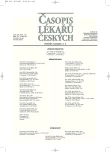Phototoxic Reaction After the Systemic Administration of Antimicrobial Drugs
Authors:
L. Malina
Authors‘ workplace:
Kožní klinika 1. LF UK a VFN, Praha
Published in:
Čas. Lék. čes. 2007; 146: 451-453
Category:
Review Article
Overview
Several systemically administered drugs with antimicrobial effect have undesirable phototoxic effects. This group includes some antibiotics (e.g., tetracycline, fluorochinolons, and also macrolids), sulphonamides and related chemotherapeutics, antimycotics, tuberculostatics, antiviral drugs and antimetabolites. Doctors should know the phototoxic effect of those drugs in advance, because of the possible time shortage they might have when they prescribe the drugs. The first condition is to obtain the relevant personal history data, and in case the phototoxic reaction develops, to terminate the unsuitable drug, to change it for another, to administer antihistaminics, sometimes corticoids, prevent exposition to sun, and administer local anti-inflammatory dermatological drugs.
Key words:
phototoxicity, photosensitization, UV light, UVA, UVB, antimicrobial drugs.
Labels
Addictology Allergology and clinical immunology Angiology Audiology Clinical biochemistry Dermatology & STDs Paediatric gastroenterology Paediatric surgery Paediatric cardiology Paediatric neurology Paediatric ENT Paediatric psychiatry Paediatric rheumatology Diabetology Pharmacy Vascular surgery Pain management Dental HygienistArticle was published in
Journal of Czech Physicians

Most read in this issue
- Bioequivalence Studies of Pharmaceutical Preparations
- Study of the Eosinophilic Inflammation Activity in Bronchial Asthma
- Stress Cardiomyopathy
- Is Prescription of Physical Activity a Part of Health Care in Civilization Disorders? Results of Questionnaire Study in Medical Doctors
